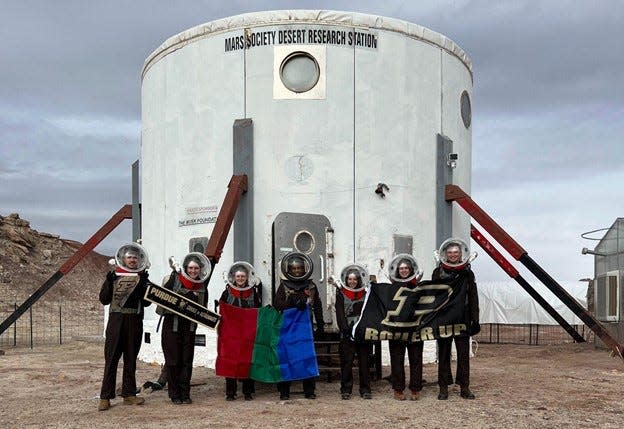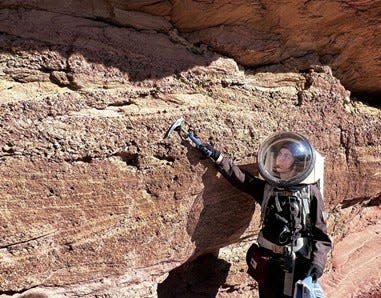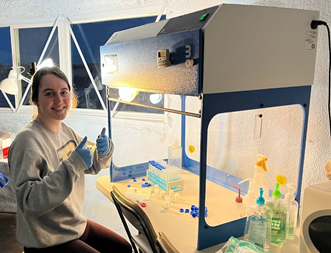Q&A: A sit down with Crew 272 of the Mars Desert Research Station expedition
WEST LAFAYETTE, Ind. − Space may be the final frontier, but it is also a frontier bursting with unexplored planets, galaxies and stretches of distance that are almost incomprehensible.
For one Purdue team, they took on a small piece of space by studying Mars in a Mars Desert Research Station expedition.
The Journal & Courier recently sat down with the members of Crew 272 and a participant in Purdue Mission Control to talk about their experiences in the two-week expedition to the Mars Desert Research Station in Utah, which simulates human exploration on Mars.
The crew

A total of 11 designated roles are assigned to crew members of these expeditions, created by the Mars Society and in partnership with Purdue University. A total of five crews from Purdue have visited the Mars-like analog facility in Hanksville, UT.
The 11 roles of the crew are: commander; executive officer; health and safety officer; crew engineer; GreenHab officer; crew scientist; crew geologist; crew biologist; crew astronomer; crew journalist and crew artist.
The following are some of members of Crew 272 who participated in the MDRS expedition from Jan. 1-13 this year.
Kshitij Mall, commander of the crew and a post-doctorate associate at Purdue
Cesare Guariniello, advisor of the crew and research scientist at Purdue
Kenneth Pritchard, crew journalist and graduate research assistant at Purdue
Mason Kuhn, crew engineer and senior undergraduate student in mechanical engineering at Purdue
Eshaana Aurora, MDRS volunteer/Purdue Mission Control with a focus in 3D printing, senior in mechanical engineering and planetary sciences in undergraduate studies and representative of student organization SEARCH
Adriana Brown, crew geologist and teaching assistant with Purdue's Department of Earth, Atmospheric, and Planetary Sciences
Additional members of the crew who could not speak to the Journal & Courier include Arly Black, Madelyn Whitaker and Megan Rush.
What was day-to-day life like?
Mall: "We conduct research together. There is a home there which we called (the) habitat. And it has certain amounts of facilities like observatories to do the study of astronomy. And then we have the green houses where we grow plants and study space agriculture and agriculture on Earth...So there are all these additional facilities and people stay in the hab usually. And then we live like how the future astronauts on Mars would live."
Brown: "Every morning we woke up and we had a meal rotation...We also had scheduled in some light exercise each morning. And then after breakfast and exercise, we would do the EVA briefing. And so that's where me or whoever else is going would kind of map out the route we were taking that day, any extra safety measures we needed, the main objectives of each EVA, because they would vary."
EVAs, or extra vehicular activities, were daily missions the crew would take outside of their habitat enclosure to the outdoor environment of "Mars." Research or search and rescue EVAs were typical. For these missions, half of the team would venture out in specialized protective suits while the other half stayed in the habitat.
Brown: "For example, for on EVA for my research, was studying to rock record to look at ancient environments. So there were specific indicators I was looking for in the rock record. I kind of briefed the team on that before we set out into the field."
Pritchard: "Others would just stay in the habitat and work on our reports. So every day we also made different reports depending on our roles. I was the journalist so I wrote up kind of a sensationalized summary of our day. Adriana worked on an EVA report based on the geology research that she had been conducting. Mason worked on engineering reports...and everybody would submit these reports to Mission Support so at the end of the day we had a communication window...We had a communication window with the on-site support."
Purdue Mission Control's participation
From 7-9 p.m. each day, the crew had a window of opportunity to talk to the Mission Control back on "Earth." Weather updates, reports on the day and more were typically discussed during these windows.
Aurora: "Basically we wanted to try and maximize as much as we could take out of an MDRS experience and go beyond just the seven crew members. And so, what we did was pair up people who wanted to volunteer and people who wanted to get their hands on some kinds of research...and we paired them up with the seven crew members. And some of the projects that we did was 3D printing...Basically to summarize what we did as not being part of the crew but being a helpful hand was PMC (or) Purdue Mission Control. There would be messages sent out by the person who was heading mission control and each different sub-crew that was working with each crew member would send some kind of (information to the crew) and that would pretty much all more than just seven people to work on this analogue mission."
Why join the crew?
Guariniello: "I had a very precise reason in this case for this crew. Kshitij was nice enough to ask me to advise and help a little bit because I had multiple experiences there (at MDRS). For my first five participations, the reason to me (for participating) is I love space. Last year, I unfortunately failed the European Space Agency Astronaut selection, I'm from Italy. I got top 400 out of 23,000...I want to prove myself and see, can I actually spend some time in a confined environment with people and survive."
Mall: "Purdue and Cesare and others who eventually selected me (as crew commander) had been kind enough to have a person of color to be commander. This was the first time that happened. So that is something new and last time I went, I went as executive officer, which is second to the commander...So when I wanted to go that was in my mind like 'What new am I going to offer to the team and how will I be useful.'"
Kuhn: "It was so unique and that paired with having a passion for research and space in general is just like the perfect opportunity. I would say one additional thing for me specifically, the timeline of my college education, how it lined up, I was unable to go on a study abroad trip...because of COVID, and so this was like the last opportunity to go somewhere for something semi-related to school."
Aurora: "Even though I wasn't part of the crew, I did apply to be a part of MDRS , but I didn't get to be a part of the seven members that went. Despite that, what I experienced was surely amazing...Just having access to all these kinds of people who share the same passion was an experience in itself. What goes on back stage, just being a part of that has made me appreciate exactly what people do and what it is like to be an astronaut."
What did you learn?

Guariniello: "In my case, I learned a lot. Professionally, I'm doing also geology research there and I've been crew geologist, commander, executive officer and health and safety officer. So I really learned how to be in different roles and do different things."
Mall: "Because I am going a second time, I knew a few of the things. But since I had to be leading and commanding, I needed to know all the systems and everything (better). Also, I needed to actually get some of these certifications such as flying (a) drone...I actually learned how to lead better. In my team, everyone was from another country, so there was that different cultural aspect."
Brown: "I definitely grew a lot from that experience. Throughout Purdue, I've taken a lot of classes about geology and the things I'd be doing, but it's very different when you're out there in a remote location doing them. For me it was a really great exercise in building from the ground up (with research)."
Pritchard: "I've been writing for a few semesters and doing research all about the challenges of deep space habitats and how we can overcome them. But actually experiencing some of those challenges first hand is a whole different story. And I think it added a lot to what I'm writing about for my Master's thesis."
Kuhn: "One of the biggest things I learned about analogues in general is how important those relationships are. It affects your productivity level, your sanity and if things aren't going right with your coworker/friends, it makes it a whole lot harder."
Did this experience help you with your future goals?

Mall: "In the future, I want to be in the Human Spaceflight Programme of India and work on the Martian missions of India...I want to be involved in those where I actually...can help bring something together for the world. So this project helped me there."
Brown: "I can say this probably got me into grad school. It was brought up in every single interview...(It) made me a much stronger candidate for these programs. And then having done it, now I feel much more prepared for walking into a program where I'm going to be doing field work and I need to organize it and I'm going to be working with different people from different fields of study. It's been really, really useful."
Kuhn: "I like to think that it definitely helped me secure (my) job. That helped with that future endeavor. After being at MDRS, my interests are much more skewed towards space industry now, rather than the automotive industry. And so...I can't imagine it would be harmful in anyway to do a two week long analogue mission. It'll be very helpful and a great resume item."
What was the hardest part of the expedition?
Pritchard: "The food wasn't great overall. The personal space was pretty limited. I think one of the hardest parts was just going back to school and all the regular obligations of life on Earth and all kinds of different school work and different things...It's a lot more complicated on Earth"
Kuhn: "The main one was learning so many new things all at once and being able to excel in all those areas. I've never emptied a septic tank before and I did that eight times over 14 days...Measuring the charge level on the suits. If I do that incorrectly and somebody's suit dies while we're out in the field then that's technically a space death...It was stressful to excel at so many things all at once."
Would you do it again?
The answer to this questions was an overall resounding yes, with Guariniello, Mall and Brown having active plans to do the MDRS expedition again later this year.
To learn more about MDRS, visit Mall's YouTube channel that has videos about the crew's recent experiences or read more on mdrs.marssociety.org. If you are interested in participating on an MDRS crew, visit Purdue's website about applying online.
Mall noted his and the crew's thanks to the expedition's 12 sponsors, which include the Purdue School of Aeronautics & Astronautics, the Honors College and more. Mall stated that without the sponsors, "I think we wouldn't have made it."
Margaret Christopherson is a reporter for the Journal & Courier. Email her at mchristopherson@jconline.com and follow her on Twitter @MargaretJC2.
This article originally appeared on Lafayette Journal & Courier: Members of simulated Mars expedition crew 272 spoke with the Journal & Courier
